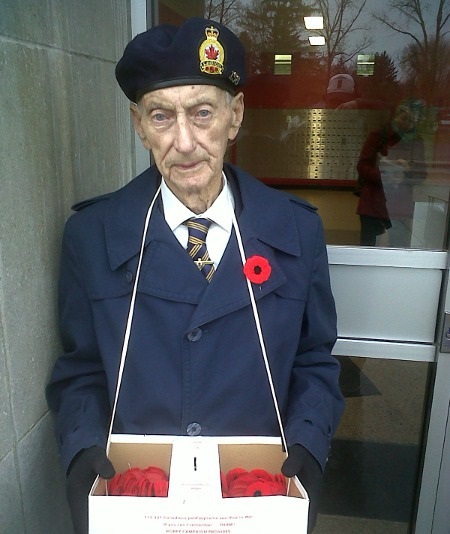The Greatest Generation is a term coined by journalist Tom Brokaw in reference to those who grew up during the Great Depression and went on to fight in World War II. Brokaw described them as, “the greatest generation any society has ever produced,” arguing that rather than fighting for fame and recognition, these men and women fought because [history has shown] it was the right thing to do.
Following the war it was this Greatest Generation who came home to build the social, cultural and economic strength that we all continue to benefit from today. I think of 65 years of new and expanding commercial, industrial and agri-business that rebuilt strong North American economies. Today we continue to see their significant contributions to science, literature, art, industry, and a renewed economic strength unparalleled in history.

As with those who fought WWI, this generation was united by a common purpose, and by common values—values that include duty, honour, economy, courage, service, love of family and country, and, above all, responsibility for oneself. Instead of state-of-the-art technology, they had loyalty, integrity, and determination that overshadowed any fears. We should all strive to emulate their examples of selflessness and noble character.
There is one clear difference between that generation and subsequent ones – no sense of entitlement. No one believed that he or she was entitled to special privileges and no one expected the world to be fair. They took the world as they found it, made the best of it, and then made it better.
They succeeded on every front. After returning victorious from the war, they immediately began the task of rebuilding their lives and the world they wanted. Marrying in record numbers, they gave birth to the next distinctive generation known as the Baby Boomers. Despite the accomplishments and essential contributions as they experience the twilight of their adventurous and productive lives, the Greatest Generation remains, for the most part, exceptionally modest. They have so many stories to tell, stories that in many cases they have never told before, stories that we can all learn from if we only take the time to listen.
We have many opportunities at this time of year to recognize the dedication and service of this generation – and others – who fought for us.
While our thoughts and thanks go to those who are presently on, or supporting, the front lines, we must continue to learn from the lessons of the past – those that were taught to us by the ‘Greatest Generation’. For the Silo, Toby Barrett MPP.
Vimy Ridge, then Hill 70, Passchendale, Cambrai . . .
Beyond Vimy, the Great War saw a number of other significant battles 100 years ago.
Vimy Ridge, fought in April 1917, is held up as the first battle when the four divisions of the Canadian Expeditionary Force fought together for the first time. It was a defining moment in Canadian history where our young nation became its own country.
There were other key battles in 1917 – battles, as did Vimy, that took a heavy toll on so many from Haldimand and Norfolk and across the Dominion.
The Battle of Hill 70 commenced on July 31, 1917. When Sir Arthur Currie was given the objective of assaulting Lens, he devised the plan of capturing Hill 70, north of the city. It was known this would result in a German counterattack.
Hill 70 resulted in death for more than 9,000 Canadian soldiers. The Germans paid a higher price, with 25,000 killed or wounded. After Hill 70, 29 families in Norfolk County alone received the dreaded telegram informing them of the demise of a loved one. The attack on Hill 70 ended with Norfolk’s highest death toll of any during the First World War.
Passchendale was the next major objective for the Canadian Corps, a 100,000-strong fighting force. Despite months of bloody fighting, the ridge was still held by the Germans. Buoyed by the success at Vimy, British commander Haig tipped his hat to the Canadians for a victory. Canadian commander Sir Arthur Currie objected, predicting it could cost 16,000 casualties. Currie had time to prepare, and planned the assault, knowing artillery and the engineers were key to victory.
The Canadians arrived in Belgium in mid-October 1917 to relieve Australian and New Zealand troops. What they found was the most horrible, muddiest conditions of the entire war. By Nov. 6, with 15,654 casualties, including 4,000 dead, the Canadians captured the village of Passchendaele. The remaining Germans on the ridge were cleared on Nov. 10 to end the battle as another brutal and costly Canadian victory.
During the fight, nine Canadians earned the Victoria Cross. Passchendale boosted our Canadian reputation as the best offensive fighters on the Western Front.
Cambrai, a surprise attack launched on Nov. 28, was a turning point in the First World War, as it marked the first time tanks were used in any number. First used in the Somme in 1916, tanks hadn’t won a stellar reputation as effective artillery machines. In fact, the Germans looked on them with disdain, assuming they could halt them with concentrated artillery fire.
The British stuck by the tank concept, positive that the muddy conditions in which the new machinery debuted in September 2016 was related to the dismal performance. The plan was to use tanks to push back the German lines, accompanied by infantry, calvary, another 1,000 guns and aerial support. The surprise attack was launched on Nov. 20 and was successful. The Germans were pushed back four miles, but later regained much of the ground in a counterattack. The slaughterhouse of Cambrai resulted in close to 100,000 casualties on all sides.
Hill 70, Passchendale, Cambrai, plus Vimy, were the major conflicts of 1917, but there were others, including Scarpe, Arras, Arleux, Ypres, Pilckem, Langemarck, Menin Road, Polygon Wood, Broodseinde and Poelcappelle.
To the glorious memory of those who died and to the undying honour of those who served. Haldimand-Norfolk MPP Toby Barrett.